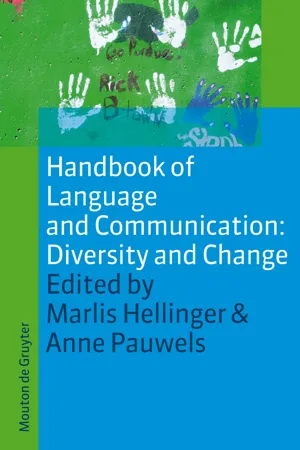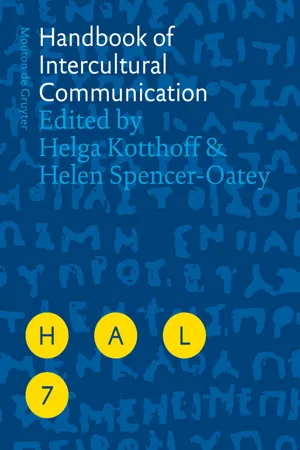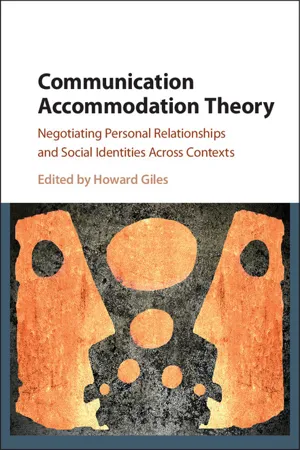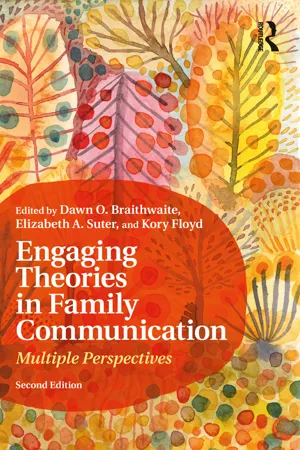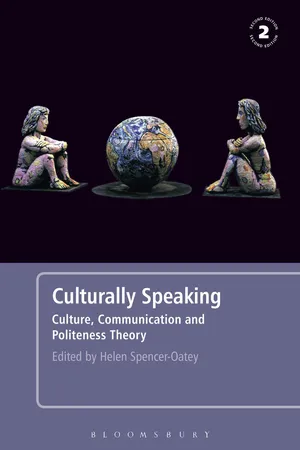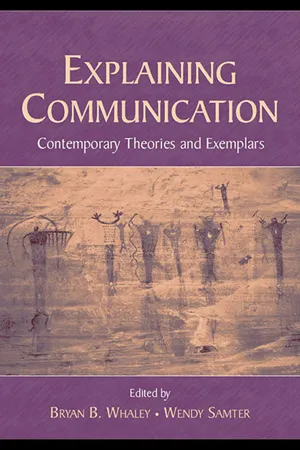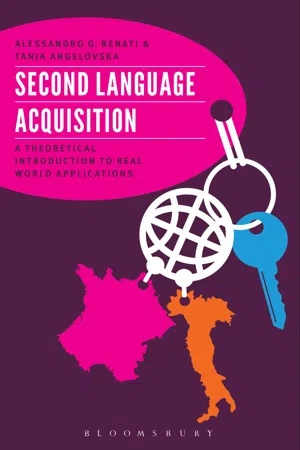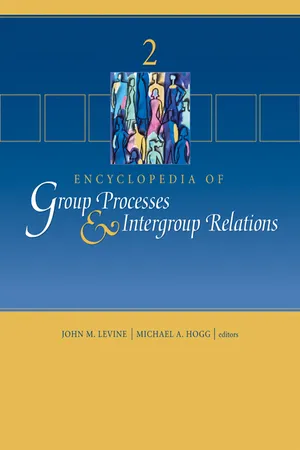Languages & Linguistics
Communication Accommodation Theory
Communication Accommodation Theory (CAT) explores how individuals adjust their communication styles to either converge with or diverge from others. It emphasizes the role of social identity and the desire for social approval in shaping communication behaviors. CAT suggests that accommodation can lead to improved understanding and rapport between speakers, but it can also reinforce social hierarchies and power dynamics.
Written by Perlego with AI-assistance
Related key terms
1 of 5
11 Key excerpts on "Communication Accommodation Theory"
- Marlis Hellinger, Anne Pauwels, Marlis Hellinger, Anne Pauwels(Authors)
- 2008(Publication Date)
- De Gruyter Mouton(Publisher)
4.4. Communication Accommodation Theory Communication Accommodation Theory (CAT) is closely related to social iden-tity theory, but was developed independently of it (see Giles and Powesland 1975; Giles, Mulac, Bradac, and Johnson 1987). Communication accommo-dation theory in its earliest form was intended to explain the communicative moves of interactants toward each other’s language or speech style (conver-gence) or away from each other (divergence) in terms of interpersonal and in-tergroup motivation and language attitudes. As Giles (1973) pointed out, it was also developed in reaction to sociolinguistic theories of accommodation that placed no emphasis on motivation, so that language and communication atti-tudes are part of the theory’s core. Like social identity theory, Communication Accommodation Theory presupposes that people act through their beliefs and be-haviour to enhance the power and status of their ingroups at the expense of out-groups. Thus, as it is for social identity theory, diversity is a source of social comparison and self-esteem. Giles and Coupland (1991) highlighted that the ways in which individuals subjectively define a situation, and their correspond-ing salient identities for that particular context, predict language diversity. Thus, levels of low or high linguistic diversity occur to varying degrees across a range of social situations. The differing cognitive structures construed by interactants during social encounters which vary in levels of personal or group salience, competitiveness, task focus and levels of formality and inequality determine the conscious or subconscious choice of varying speech patterns (see Giles and Coupland 1991: 18–19). 610 Cindy Gallois, Bernadette Watson and Madeleine Brabant Over time, Communication Accommodation Theory (see Gallois, Ogay, and Giles 2005) has developed into a comprehensive theory of interpersonal com-municative behaviour in intergroup contexts.- eBook - PDF
- Helga Kotthoff, Helen Spencer-Oatey, Helga Kotthoff, Helen Spencer-Oatey(Authors)
- 2008(Publication Date)
- De Gruyter Mouton(Publisher)
Communication is viewed not so much as a skill but rather as the result of a motivation (identity maintenance or negotiation, reduction of prejudice, etc.), based on intergroup history. Miscommunication is construed not as a defi- Psychological perspectives 67 ciency of the individual but rather as based on the motivations that underlie one or both interactants in an intercultural encounter. This approach to intercultural communication acknowledges that because of the socio-historical context and intergroup relations, people may not be moti-vated to communicate well. Members of the dominant group may not be tolerant of the efforts made by members of a less dominant group, and in any case inter-group relations are salient in most interactions. In addition, in this approach there is an understanding that some encounters will not proceed smoothly and these encounters may be better avoided. One weakness of this perspective lies in the inherent complexities in these theoretical approaches that attempt a compre-hensive explanation of intercultural encounters. By including so many vari-ables, it is difficult to tease out when particular elements are salient in the model and when they are not. 3.5. Communication Accommodation Theory Communication Accommodation Theory (CAT: e.g. Gallois et al. 1995; Giles, Coupland and Coupland 1991) is a theory of both intergroup and interpersonal communication, invoking the dual importance of both factors in predicting and understanding intergroup interactions. In our introduction, we noted that CAT proposes that communication has both interpersonal and intergroup elements. It is this combination that makes CAT such a powerful model. For example, Jones et al. (1999) used CAT to explain differences in the communication dynamics between Australian and Chinese students studying at an Australian university. - eBook - PDF
Communication Accommodation Theory
Negotiating Personal Relationships and Social Identities across Contexts
- Howard Giles(Author)
- 2016(Publication Date)
- Cambridge University Press(Publisher)
10 Communication Accommodation Theory: Integrations and New Framework Developments Cindy Gallois, Jessica Gasiorek, Howard Giles and Jordan Soliz The chapters in this book canvass a wide variety of contexts, and provide a strong sense of how Communication Accommodation Theory (CAT) has developed and where it is today (see also, Giles, Gasiorek, & Soliz, 2015). In this final chapter, we aim to look forward and give a sense of where CAT might go. Since its inception, and particularly for the past thirty-plus years, the challenge for CAT has been to maintain coherence while being both compre- hensive and useful for scholars using a variety of methodological approaches and in a range of applied contexts. Rather than being a drawback, this challenge is a natural part of any theory’s growth and development. However, it does require attention. Taking into account the research agendas and meth- odological reviews synthesized for this volume, this final chapter aims to address this challenge and in so doing, provide a guide for both theorizing and empirical research with CAT for the next decade and beyond. In the following sections, we consider the Principles of CAT, then describe some conceptual, methodological, and contextual vistas we see for the theory, highlighting ways in which research using CAT can move forward. Principles of CAT Before going further, we believe it is important to revisit the Principles of accommodation (see Chapter 3), as a means to reflect on the major themes and contributions of CAT. The Principles are general, by design, and they capture all the core features and propositions in CAT concisely. That said, in their wording and formulation, they could be seen as prioritizing certain aspects of the theory. First, they emphasize the perceptual and motivational parts of the theory, which have become increasingly prominent over the years. - eBook - ePub
Engaging Theories in Family Communication
Multiple Perspectives
- Dawn O. Braithwaite, Elizabeth A. Suter, Kory Floyd, Dawn O. Braithwaite, Elizabeth A. Suter, Kory Floyd(Authors)
- 2017(Publication Date)
- Routledge(Publisher)
By identity, we are referring to idiosyncratic aspects of individual family members (e.g., personality), family members’ connection with various social identities (e.g., religion, ethnic-racial identity, age group, gender), and the overall relational or family culture. Thus, there is a clear intersection between family communication and these different dimensions of identity. Why do we talk with our parents in a style that is often very different from how we interact with siblings? How do family members talk with each other about social issues when they have distinct political and religious orientations? Do the expectations about how we interact and communicate in our family reflect who we are as individuals? Does our family interact in ways that differ from social expectations on how families should be? If so, does this affect our perceptions of our family and ourselves? In this chapter, we introduce two theories of communication that address these types of questions and various others that attend to identity and difference in family: Communication Accommodation Theory and communication theory of identity. We begin with Communication Accommodation Theory.Intellectual Tradition of Communication Accommodation Theory
Communication Accommodation Theory (CAT) emerged in the early 1970s (e.g., Giles, 1973) as a framework to understand the motivations for and ways in which individuals adjust their speech (e.g., dialects, accents) in interactions. CAT further developed over the next few decades to include a wider range of behaviors we may adapt in interactions (e.g., topic of discussion, various nonverbal cues) and evaluative outcomes (e.g., communication satisfaction, interpersonal solidarity, attitudes toward individuals and social groups) of these communicative shifts (for review, see McGlone & Giles, 2011). Further, the theory posits that there are various factors that influence our motivations for communicative shifts, as well as the manner in which we perceive the way in which others communicate with us.CAT emerged from a post-positivist tradition relying primarily on experimental methods in early development of the tenets and propositions of the theory. However, as outlined by Gallois, Weatherall, and Giles (2016) and Soliz and Bergquist (2016), CAT has emerged as a theory of paradigmatic utility guiding research on a variety of orientations and methodologies (e.g., discourse and conversational analysis, survey designs, experiments, ethnography, qualitative interviews). CAT’s heuristic value as a theory is evidenced in its application to a variety of contexts (e.g., intercultural relations, intergenerational interactions, patient-physician communication, police-civilian relations, computer-mediated discourse). Further, one of the reasons CAT has “morphed into a communication theory of enormous scope” (Griffin, 2009, p. 397) is because it attends to both interpersonal and intergroup dynamics of interactions. - eBook - PDF
Culturally Speaking Second Edition
Culture, Communication and Politeness Theory
- Helen Spencer-Oatey(Author)
- 2008(Publication Date)
- Continuum(Publisher)
Of course, speakers' appreciation of their own contexts of communication is often incom- plete; they may, for example, be unable to predict how hearers will judge their commu- nication strategies. This means that accommodating can often be fraught with uncertainties and, for example, miscarried attempts at convergence. Communication Accommodation Theory therefore has considerable relevance to our understanding of miscommunication (Coupland et al. 1991), particularly between social groups where normative expectations for talk are not fully shared. (I consider one instance in detail in the next section.) Finally in this section, it is important for us to recognize how accommodation research has begun to engage with discourse analysis and pragmatics, in place of the rather mechanistic descriptions of speech and language variables that it dealt with in its early years. The early studies, and so the early development of the theory, depended on quantitative measures. Convergence and divergence were quantified as shifting values of measurable variables, such as phonological or dialect standardness and the frequency of use of specific language codes. Quantification was important in establish- ing the basic claims of the model, for example that linguistic convergence is regularly associated with perceived solidarity, and divergence with psychological dissociation. But it is clearly the case that 'being accommodative' is realized through a very wide range of discourse moves and strategies, and that these are fundamentally interactive in nature. - eBook - ePub
Explaining Communication
Contemporary Theories and Exemplars
- Bryan B. Whaley, Wendy Samter, Bryan B. Whaley, Wendy Samter(Authors)
- 2013(Publication Date)
- Routledge(Publisher)
Like the above-mentioned research of Thomson et al. (2001), Crook and Booth (1997) studied accommodation in a rather new albeit increasingly used communication media: electronic mail (e-mail). Because feedback, if there is any, is slow in this written media (compared to face-to-face interaction in which additional questions, the use of gaze and silence as well as other signals provide the sender with cues to how the message is interpreted), accommodation from the writer to the recipient is crucial to increase communication effectiveness. According to these scholars, one dimension of diversity between individuals is their preference for a sensory system over the others: the three primary visual, auditory, and kinesthetic (body) senses. These preferred sensory system are reflected in language use through words like “see,” “clear,” “looks like” (visual style), “hear,” “sound,” “ringing” (auditory style), and “feel,” “grasp,” “touch” (kinesthetic style). Their results showed that individuals who received e-mails that matched their preferred representational system reported more rapport with the sender than those who received e-mails that did not match their preferred style. An implication of this finding is that, if one does not know the receiver's preferred sensory system in advance, one should take care to write a message that addresses the three styles.CONCLUSION
In this chapter, we provided a flavor of the basics, as well as the inherent complexities, of Communication Accommodation Theory. As we have seen, many disciplines (besides Communication) have profited from its insights and herein we have selected an array of experimentally controlled laboratory and naturalistic studies from around the world designed to explore its dynamics. As readers will have gleaned from recurring treatments of our opening scenario, there are a plethora of communicative options for, and reactions of, people interacting (who have personal and many social identities). We contend that CAT—with its attention to macrocontextual forces, interpersonal and intergroup dynamics, motives, and social consequences—can handle these (and other) intricacies. That said, and although it could arguably be infinitely elaborated to take account of expectancy violations, arousal, cognitive schemas, relational development, and so forth, it was never conceived to be a theory for all interpersonal eventualities. Nonetheless, a person's accommodative resources and flexibility may make up a hitherto unrecognized statement about their “communicative competences,” and CAT has the potential to be associated with a very wide range of individuals' uses of communicative actions (e.g., forms of address, politeness, cosmetic styles, car and interior design choices, etc.). - eBook - PDF
Second Language Acquisition
A Theoretical Introduction To Real World Applications
- Alessandro G. Benati, Tanja Angelovska(Authors)
- 2016(Publication Date)
- Bloomsbury Academic(Publisher)
Howard Giles’ Accommodation Theory (or Speech Accommodation Theory) shares several theories with the Acculturation Model, but it also has several other signi fi cantly different aspects. For Giles, motivation levels re fl ect how individual learners will de fi ne themselves and as a consequence how they change, adjust and accommodate their speech. The theory observes how speech patterns converge or diverge within different social interactions and group constellations. Central to this framework is the notion that speakers are motivated to adjust their speech when interacting with each other. They mainly accommodate their speech when they desire social approval and/or high levels of communicational ef fi ciency. Success will depend on the learners’ individual differences and environmental factors as well as each speaker’s available language repertoire. SLA extended: communicating in a world with bilinguals, heritage and multilingual speakers Given the mobility and migration so common today, as well as economic, trade, cultural, educational and other kinds of encounters – individuals pursue their goals and exchange information by communicating both face-to-face and online in many international settings. These situations often require interlocutors to use a commonly shared or widely understood language, even if it is not their mother tongue. Such a helpful tool is called a ‘lingua franca’ (Jenkins 2015, Seidlhofer 2011). English is a widely used lingua franca. According to 2012 Eurobarometer 386, it is by far the language that most Europeans are likely to speak as their fi rst (that is, most fl uent) foreign language (32 per cent) (Eurobarometer 386: 20). Speakers might use the lingua franca in different ways depending on the various linguistic practices they have been exercising previously, different S L A extended: communicatin g in a w orld with bilin g uals, herita g e and multilin g ual speakers - eBook - PDF
- A. Weatherall, B. Watson, C. Gallois, A. Weatherall, B. Watson, C. Gallois(Authors)
- 2007(Publication Date)
- Palgrave Macmillan(Publisher)
By differentiating subgroups of language community members according to their acculturation orientations, we may be in a better position to identify the subgroup of community leaders most likely to promote more fruitful compromises between competing language communities, thus reducing tensions between linguistic minorities and majoritities. As seen in Communication Accommodation Theory (CAT), language strategies such as convergence, maintenance and divergence provide a vivid reflection of relational outcomes emerging between speakers of contrasting language communities. Current research should help uncover the acculturation orientations most likely to yield harmonious, problematic and conflictual relational outcomes as expressed through the code-switching strategies proposed within CAT. author note Comments are welcome and can be addressed to Richard Y. Bourhis and Shaha El-Geledi, Département de psychologie, Université du Québec à Montréal, Canada, CP 8888, Succ.Centre-Ville, Montreal, Canada, H3C 3P8. bourhis.richard@uqam. ca; [email protected], or to Itesh Sachdev, School of Oriental and African Studies, University of London, Thornhaugh Street, Russell Square, London, England, WC1H 0XG. [email protected] references Abrams, J., O’Conner, J. & Giles, H. (2002). Identity and intergroup communication. In W. B. Gudykunst & B. Mody (Eds.), Handbook of international and intercultural communication (2nd ed., pp.225–240). Thousand Oaks, CA: Sage. 42 language, accommodation and intercultural encounters Allard, R. & Landry, R. (1986). Subjective ethnolinguistic vitality viewed as a belief system. Journal of Multilingual and Multicultural Development, 7, 1–12. Allard, R. & Landry, R. (1994). Subjective ethnolinguistic vitality: A comparison of two measures. International Journal of the Sociology of Language, 108, 117–144. Amiot, C. & Bourhis, R.Y. (1999). Ethnicity and French-English Communication in Montréal. - eBook - ePub
- Margaret McLaughlin(Author)
- 2012(Publication Date)
- Taylor & Francis(Publisher)
1 • Speech Accommodation Theory: The First Decade and Beyond Howard Giles • Anthony Mulac • James J. Bradac • Patricia Johnson University of Bristol • University of California —Santa Barbara • University of BristolT HE first publications concerning “speech accommodation theory” (SAT) emerged in 1973. Giles (1973) not only demonstrated the phenomenon of interpersonal accent convergence in an interview situation, but also introduced his “accent mobility” model in the context of a critique of some aspects of the Labovian (1966) paradigm (see also Bell, 1984). This was a blueprint for subsequent formulations addressing a greater diversity of speech levels (Giles & Powesland, 1975). To this end, and in that same year, Giles, Taylor, and Bourhis (1973) published a paper that confirmed empirically some fundamental ideas inherent in what subsequently was to be labeled SAT. In a bilingual context, they found that the more effort in convergence a speaker was perceived to have made, the more favorably that person was evaluated and the more listeners would converge back in turn. Moreover, a plethora of convergent strategies was discovered even in what for some would be described as a socially sterile laboratory setting. Since then, empirical and theoretical developments and consequences have been somewhat profuse, and particularly so in the 1980s (for example, Ball, Giles, & Hewstone, 1985; Giles, 1984). Hence, the aim of this state-of-the-art chapter is to present a concise overview of SAT achievements to date, to renovate some of its propositional components in the light of recent thinking, and to lay down some priorities for future research.SAT, developed by Giles and associates, focuses on the social cognitive processes mediating individuals’ perceptions of the environment and their communicative behaviors. Its theoretical framework developed out of a wish to demonstrate the value and potential of social psychological concepts and processes for understanding the dynamics of speech diversity in social settings. It purports to clarify the motivations underlying, as well as the constraints operating upon, speech shifts during social interactions and the social consequences of these. Specifically, it originated in order to elucidate the cognitive and affective processes underlying speech convergence and divergence, although other speech strategies (for example, speech complementarity and speech competition) have come into its theoretical purview more recently. - eBook - PDF
- Various Authors(Author)
- 2021(Publication Date)
- Routledge(Publisher)
M., & Bourhis, R. Y. Towards a theory of interpersonal accom- modation through speech: Some Canadian data. Language in Society, 1973, 2, 177-192. Gudykunst, W. B. (Ed.). Intergroup communication. London: Edward Arnold, in press. Harre, R., & Secord, P. F. The explanation of social behaviour. Oxford: Blackwell, 1972. Heider, F. The psychology of interpersonal relations. New York: Wiley, 1958. Hymes, D. Models of the interaction of language and social setting Journal of Social Issues, 1967, 23, 8-28. Jones, E. E., & Davis, K. E. From acts to dispositions: The attribution process in person perception. Advances in Experimental Social Psychology, 1965, 2, 220-267 Kelley, H. H. Attribution theory in social psychology. Nebraska Symposium on Motiva- tion, 1965, 15, 192-238 Kelley, H. H. The process of causal attribution. American Psychologist, 1973, 28, 107- 128. Kelly, G. A. The psychology of personal constructs. New York: Norton, 1955. Labov, W. The logic of nonstandard English, Georgetown Monographs on Language and Linguistics, 1969, 22, 1-31. Lambert, W. E. A social psychology of bilingualism. Journal of Social Issues, 1965, 23, 91-109. Moscovici, S. On social representations. In J. P. Forgas (Ed.), Social cognition: Perspec- tives on everyday understanding. London: Academic Press, 1981. Moscovici, S., & Hewstone, M. Social representations and social attributions: From the 'naive' to the 'amateur' scientist. In M. Hewstone (Ed.), Attribution theory: Social and functional extensions. Oxford: Blackwell, 1983. Osgood, C. E., Suci, G. J., & Tannenbaum, P. H. The measurement of meaning. Urbana Illinois. University of Illinois Press, 1957. Platt, J. & Weber, H. Speech convergence miscarried: an investigation into inappropriate accommodation strategies. International Journal of the Sociology of Language, 1984, 46,. 131-146. Robinson, W. P. Language management in education: The Australian experience. Sydney: Angus & Robertson, 1978. Ryan, E. B. & Giles, H. - John M Levine, Michael A. Hogg, John M. Levine, Michael Hogg(Authors)
- 2009(Publication Date)
- SAGE Publications, Inc(Publisher)
Originally, sociolinguists thought that such shifts were dictated by social situations. More for-mal situations, for example, might lead one to use more “correct” pronunciation than less formal situations. This idea was overturned, however, when Howard Giles proposed his speech accom-modation theory, now called Communication Accommodation Theory. According to this theory, people are motivated to use accommodating lan-guage when they want to express similarity and attraction, and they do so when they believe their interaction partner has legitimate social status. Conversely, when people believe the social status of others is low or illegitimate, they are likely to use divergent language. In a now classic demonstration, Richard Bourhis and Howard Giles asked Welsh second-language learners, who were highly committed to their Welsh identity, to participate in a study on second-language learning. In one experimental condition, an English experimenter who employed received pronunciation (i.e., nonregional accented English) challenged participants’ reasons for studying Welsh: “Why study a dying language with a dis-mal future?” These participants answered in a broader Welsh accent, used more Welsh terms in their replies, and referred to their Welsh identity more often than those not so provoked. The Welsh L 512 Language and Intergroup Relations speakers’ divergent replies can be understood as attempts to maintain their ethnic heritage in the face of a threat from what they considered to be the illegitimately high-status English. There is now a wealth of evidence that such linguistic shifts are driven by motivations and per-ceptions of status relations between groups. In the case of intergenerational relations, the elderly commonly experience patronizing speech from younger generations.
Index pages curate the most relevant extracts from our library of academic textbooks. They’ve been created using an in-house natural language model (NLM), each adding context and meaning to key research topics.
